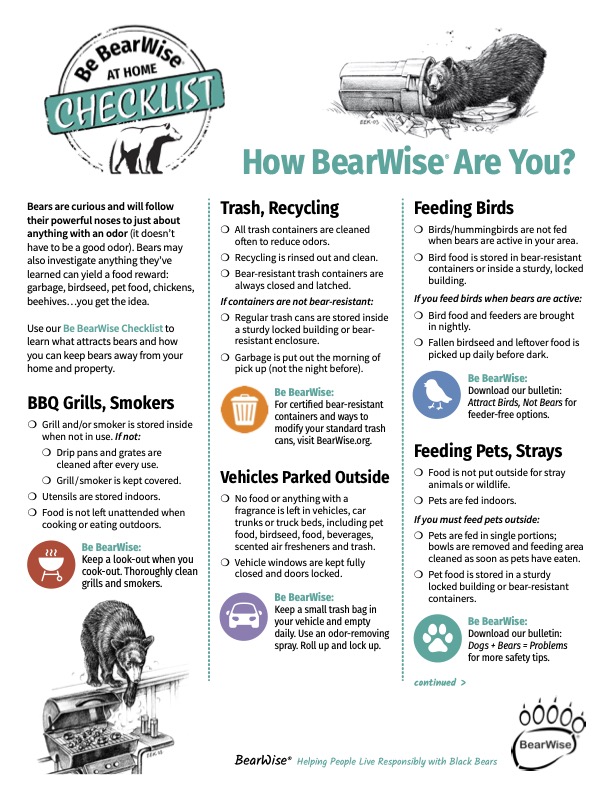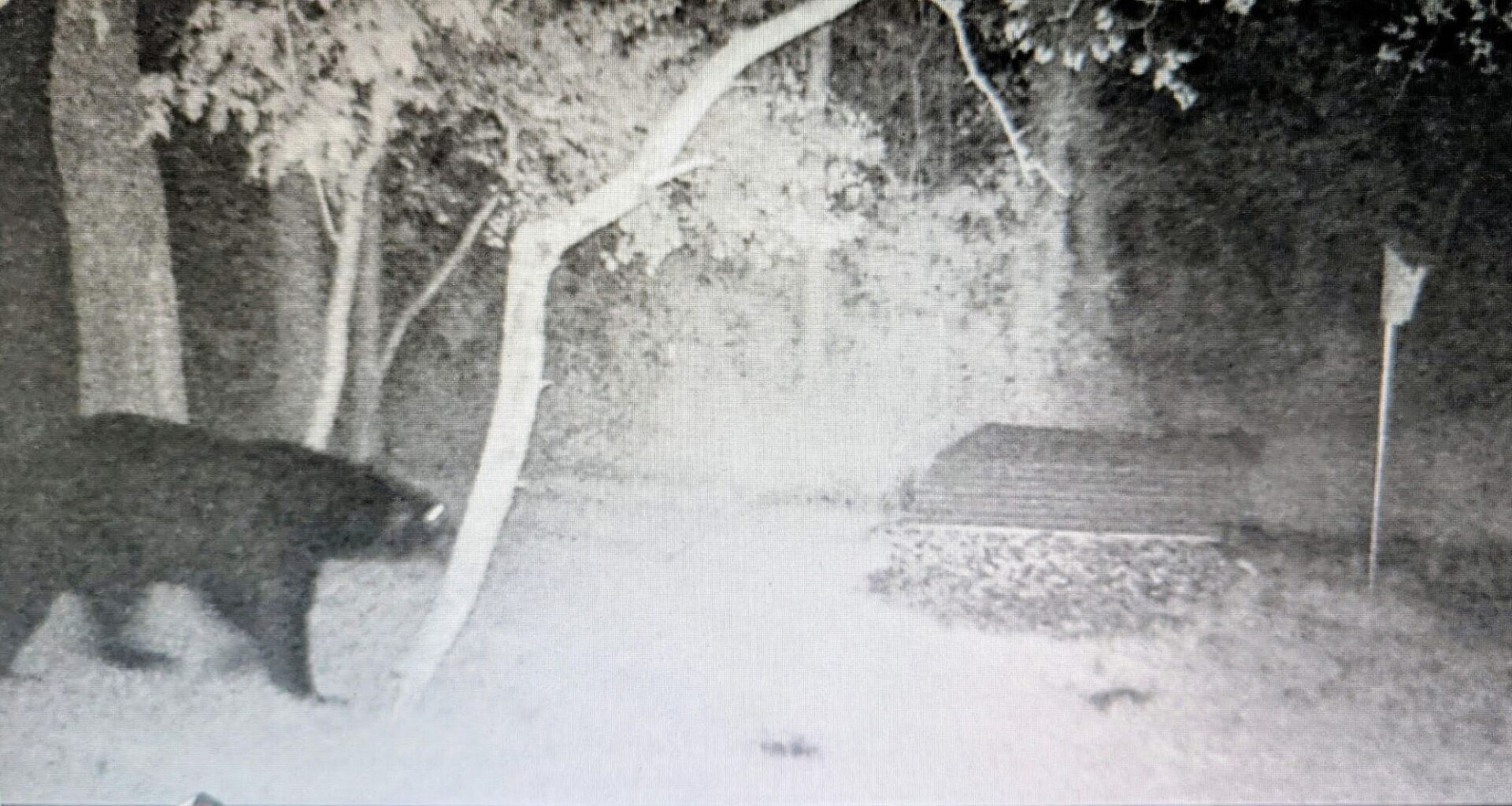ALEXANDRIA — Back in March, the Echo Press brought you a story that began, “When Andy Tri shows you, year by year, the expansion of black bears’ range in Minnesota, you almost expect to look out the window and see one ambling by.”
Dr. Andy Tri is the DNR Bear Project Leader with the Minnesota DNR’s Forest Wildlife and Populations Research Group. He’s also a Certified Wildlife Biologist (CWB®).
So imagine the Meyer family’s surprise when they looked at their trail cam footage last month and saw a black bear ambling through their Scenic Heights neighborhood north of Alexandria. Amanda Meyer sent us this photo from her father-in-law, Allan Meyer.
“The photo was taken on the trail cam around 10:30 p.m. on June 2nd. at the beginning of June,” writes Amanda Meyer. “The trail cam is right in their yard, right by their house. Have there been other bear sightings in town?”
“Every sighting so far in the area seems to have been solo bears, and are likely males out and about,” says Tri. “It’s just a natural thing. Bears are essentially re-colonizing areas they haven’t been in a long time. Around Alex, we are seeing more and more bears every year, but it’s just kind of a natural expansion of the bear range. This is the time of year, though, where we see all kinds of bears showing up where people don’t necessarily expect them. Moms kicked out the yearlings and there’s a lot of young male bears out and about trying to figure out how to be a bear and how to find a place to call their home. And also, you’ve got some other permanent dispersal going on for the larger critters. These are more mature males looking to find a territory home range for them to call their own and start finding a mate.”
“May and June is breeding season,” Tri continues, “and male bears will cover something like up to 100 or 150 miles in some cases, just to find a few females. The males are the ones that show up first with range expansion. It’s the tail end of breeding season and the male yearlings are out finding new places to live, so lots of bears are showing up in places the public doesn’t expect.”
Image and PDF Viewer

Click the image above to view the PDF document.
But bears where people don’t expect them can be unnerving, to say the least. “Bears are not an inherent threat to human safety or anything like that,” says Tri. “You know, a big male bear is the same risk to your birdfeeders and trash as a female is. Males often get into trouble. They’re a little more bold in general just because they don’t have to care for the little ones and take less risk. So oftentimes the ones that end up in human-bear conflict are males, but not always. They’re big old animals, and they want to get away from us as much as we want them away from us. So long as you respect them and give them their space, put the attractants away like bird feeders and trash — it’s generally a non-issue.”
But as bears become more common in our area, especially as we’re out camping and picnicking in the summer time, there are some common sense things folks can do, especially when it comes to birdfeeders, trash, and that old stereotype: honey.
“You know, Minnesota is now bear country. So it’s just good practice to make sure the trash cans are secured in the garage. Or a locked shed until the morning of trash pickup. Bird feeders are a big deal. It’s like candy for bears. They’d have to eat something like 20 pounds of blueberries to get the same amount of calories they would out of one black oil sunflower feeder.
“Similarly, with hummingbird feeders, we call that ‘bear Kool-Aid’ in the business. That’s a high source of calories for them that they will come a long way for. They can smell stuff from over a mile off. You know, those grease cups on grills are super attractive to Labradors, as I’ve learned in my own experience, and similarly, bears have good senses, much like dogs, and they will investigate a grill that’s not cleaned. If you’re out camping, make sure that you’re never storing your food or anything like that in your tent. No candy, no smelly toiletries, that sort of thing. Put them in your vehicle if you’re car camping or in a bear resistant container. And keep your car locked. Sometimes bears know how to figure out how to open car doors. It’s not common, but it can happen. And it’s quite a mess because the door will often shut on them. And then you have a bear in the car and you’re not quite sure what to do.
And as Douglas County prepares to become bear country, Tri says his final “hot tip” is for bee keepers.”They need to make sure that they have electric fences up to protect those hives, whether it’s hobbyists or industrial honey producers. That’s an attractant that might bring bears in (and the electric fence) is another good way to keep them away. It won’t harm them, but it’s enough to keep them out of your stuff.”
A final note about bears and dogs: Tri says many traumatic bear-human encounters take place when a dog flees back to their human, with a bear hot on their heels. “In general, what we find is that, of the times where humans and bears have made physical contact and someone has been hospitalized, about half of those include dogs that are unleashed,” he says. “And so when out hiking, keep your dog on a leash. It’s often required, but it’s just a good idea. If you’re out grouse hunting or something, just put a bell on the collar. Just so the bear is not surprised or scared — it knows if the dog’s coming from a long way off. Generally, that’ll solve 99% of the issues. If you’d like to just let your dogs run off leash at the house (or) let them out at night, just flip on a light, take a peek out, make a little bit of noise before the herd of pups charge out. And, generally that’s enough.”
Tri also recommends checking out the
. It’s spread to 40 states now and it’s geared to helping people and bears live safely next to one another.
Back in March, Tri told the Echo Press that while black bears are rare in west central Minnesota, those that have found their way here are pretty happy about it. “Oak resources — acorns — are the number one thing bears like to eat in the fall,” says Tri. “Also American hazelnuts — everyone likes those.”
West central Minnesota has good habitat for the few bears that find their way this far south and east, Tri says. “There are more oaks that produce acorns, more abundant berry production in the open canopies of west central MN, and more crops. Corn yields have tripled,” he adds, “and acres planted have increased 200%. Not all bears consume corn, but the ones who do seem to like it — a lot.”
In fact, all that abundant food means the biggest bears in Minnesota live in the transition zone between the north woods and the former prairies.

Lisa Johnson has been a broadcast journalist, anchor and producer over half her life. She started her broadcast career spinning country music at KWWK/KOLM Radio in Rochester, Minnesota. She’s worked in Moorhead, Bismarck, Wahpeton and Fergus Falls, and spent the last 30 years hosting a morning news show in Duluth. She is glad to be back closer to family in western Minnesota, and is an unabashed morning person.
Story ideas? Email ljohnson@echopress.com
